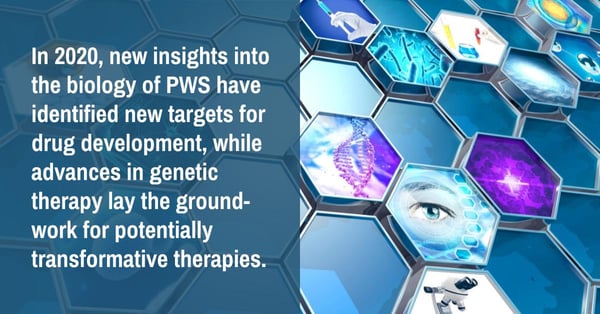Despite the enormous challenges of 2020, PWS scientists and clinicians persevered and made tremendous headway in understanding PWS, advancing new treatments, and improving care. New insights into the biology of PWS have identified new targets for drug development, while advances in genetic therapy lay the groundwork for potentially transformative therapies. Clinical trials have continued to move forward, albeit with modifications due to COVID. In addition, research into clinical care has led to some practical recommendations to improve the quality of care for individuals with PWS. All of this in the midst of a pandemic - we are incredibly appreciative of our donors and families who enable us to support the efforts of an outstanding group of PWS researchers.

To date, 20 PWS research publications have been added to the medical literature this year. Below, we highlight a few of these publications as well as provide links to each publication so that you can read them in greater detail.
Genetic Therapies for Prader-Willi Syndrome
Supporting cutting edge research to advance genetic therapy for PWS continues to be an FPWR research priority and constitutes a large portion of our research investments. FPWR-funded researcher Stormy Chamberlain, an expert in both PWS and Angelman genetics, continues to lead the PWS genetic therapy research field. Recently, she published a paper assessing the use of CRISPER/Cas9 for activating the maternal chromosome in PWS. Additionally, Dr. Chamberlain contributed a chapter on PWS stem cell models to a new textbook on titled ‘Neurodevelopmental Disorders.'
Another expert in PWS genetics and FPWR-funded researcher, Dr. Gordon Carmichael, recently published a very comprehensive review of the genetics of PWS and potential future therapies in Open Biology. This publication is an important resource for the research community providing an account of what has been completed in the field to date as well as next steps as work towards effective genetic therapies for PWS.
For an overview of genetic therapy, how it might work in PWS, and current approaches to genetic therapy in PWS being undertaken by FPWR-funded researchers, please visit our website: Genetic Therapy for Prader-Willi Syndrome.
2020 Publications Advancing Genetic Therapy for PWS
-
IPSC Models of Chromosome 15Q Imprinting Disorders: From Disease Modeling to Therapeutic Strategies
-
Prader-Willi syndrome: reflections on seminal studies and future therapies
Understanding the Biology of PWS
Another major category of work by FPWR-funded researchers provides a greater understanding the biology of PWS. One very exciting, highly collaborative paper: the loss of MAGEL2 in Prader-Willi syndrome leads to decreased granule and neuropeptide production, was published this year in JCI Insights came from the Potts lab. In this paper, they show in multiple models of PWS the amount of secretory granule proteins and the production of neuropeptides is significantly reduced compared to normal. This may explain why so many different hormonal/neuropeptide systems aren’t working properly in PWS. This work demonstrated a new role for the PWS-associated gene, MAGEL2, in regulating the production and release of a wide variety of neuropeptides. Dr. Theresa Strong goes into more details on the findings in this publication in this video blog.
Dr. Godler’s lab and colleagues recently published an article in Translational Psychiatry on the relationship between 2 PWS-related genes and autism. Increased UBE3A mRNA levels were correlated with developmental functioning scores in the deletion group, and autism features in the non-deletion PWS group.
We also have new insights into neural circuitry of feeding behaviors and the impact of the Snord116 gene on sleep and metabolism.
2020 Publications Improving Our Understanding of the Biology of PWS
-
Emerging roles of the MAGE protein family in stress response pathways
-
Unravelling the Biology of snoRNAs Implicated in Prader-Willi syndrome
-
Neural Circuit Mechanism Underlying the Feeding Controlled by Insula-Central Amygdala Pathway
-
Loss of Snord116 impacts lateral hypothalamus, sleep and food-related behaviors
Clinical Research
In 2020, FPWR published results from our text-message based weight study. The study documented weight changes over 6 months in 160 participants with PWS and provides important baseline data for clinical trials. A blog and short video detailing the results of the study can be found on our website: Changes in Weight and BMI in Adolescents and Adults with PWS.
Two separate papers from the Barone and Tauber labs in France examined facial and voice processing in people with PWS, and how that affects social interactions. These two papers are discussed in an FPWR blog: Facial and Voice Processing Issues Affect Social Interactions in PWS.
In the world of orthopedics, Dr. Harold van Bosse assessed the long-term consequences of early hip dysplasia in PWS, and the data does not support an aggressive approach to treating hip dysplasia in babies. FPWR blogged on these findings in an FPWR blog: Hip Dysplasia in Babies with PWS May Not Need Aggressive Treatment
Drs. Key and Dykens recently published a study on eye tracking, that found that children with PWS who had higher hyperphagia questionnaire scores and more advanced nutritional phases also showed greater attention to food as measured by eye tracking. This finding could lead to a new measurement of hyperphagia for clinical trials.
2020 Clinical Research Publications:
-
The modified Atkins diet in children with Prader-Willi syndrome
-
A study of voice and non-voice processing in Prader-Willi syndrome
-
Food and Non-Food-Related Behavior across Settings in Children with Prader–Willi Syndrome
-
Eye tracking as an objective measure of hyperphagia in children with Prader-Willi syndrome
-
Comparison of Hip and Knee Arthroplasty Rates of Individuals With and Without Prader-Willi Syndrome
Annual PWS Research Symposium
Covid-19 required a move from traditional in-person meetings to online forums in 2020. While everyone would agree in-person meetings cannot be replicated on zoom, taking our annual Research Symposium virtual did have a few perks, such as allowing for a larger international audience to participate. Over 40 oral and poster presentations were shared, covering everything from cellular biology to gene therapy and clinical care. Abstracts of these presentations are available for download here.








